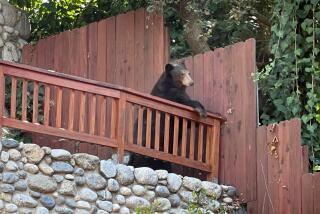Ranch’s Condor Proposal Faulted
Environmental groups and local residents Tuesday criticized a tentative plan by the Tejon Ranch Co. and the U.S. Fish and Wildlife Service that protects ranch developers if they accidentally harm or kill endangered California condors, but also takes steps to protect the huge birds.
The ranch company is seeking a federal “incidental take” permit that would shield it from liability if it unintentionally harmed North America’s largest bird during ranch activities or while building three large projects planned on the 270,000-acre property north of Los Angeles.
As part of a plan to protect condors while allowing Tejon Ranch to develop its property, officials announced at a meeting Tuesday in this Tehachapi Mountains community that about 37,000 acres on the ranch would be set aside for feeding and care of the birds.
But most of the dozen environmentalists and local residents who attended an afternoon meeting on Tejon’s permit request said they were not convinced of the company’s good intentions.
“They’re always boasting about their stewardship of the land -- you see it on their signs beside the freeway -- but we haven’t seen it yet,” said Mary Ann Lockhart, a member of the Condor Group of the Sierra Club.
Lockhart and several others complained that the public was not allowed to ask questions during the meeting. Instead, wildlife service and ranch officials answered questions individually after their presentation.
Ranch officials plan to build a 23,000-home project, a 1,450-acre warehouse park and a mountain resort community along Interstate 5, not far from ridgelines where condors regularly feed and rest.
During a joint presentation Tuesday, ranch and federal officials said their goal was to allow Tejon Ranch to develop its property while also saving condors from harm.
Guidelines have been drafted limiting the height of dwellings and prohibiting their construction along ridgelines. And if condor problems arose, a biologist would be stationed on the ranch to chase the birds away from houses and out of backyards, where they could swallow harmful debris.
“This isn’t about killing condors; this is about preserving them,” Tejon Ranch President Robert A. Stine said in an interview. “What we’re doing is setting aside tens of thousands of acres for them.”
Stine said Tejon Ranch has been in negotiations with the Fish and Wildlife Service since 1992 to determine how to pursue ranch activities and projects while also meeting federal law that protects endangered species such as the condor. He said a Kern County rancher was put in jail a couple of years ago because he ran over a protected kangaroo rat with his tractor.
“That really happened,” Stine said. “As a private land owner you run the risk of doing something you can get penalized for. So we’re entering into this agreement so we can be a good citizen and continue to do our farming activities.”
Stine acknowledged that human proximity to condors would increase in coming years because part of the firm’s planned Tejon Mountain Resort community abuts the condor preserve in the rugged center of the ranch.
Ninety-nine condors are in the wild, including 47 in California, after a 25-year, $35-million effort to save the huge birds from extinction. An additional 149 are in captivity.
The Tejon Ranch -- a prized wildlife habitat that stretches 40 miles from north to south and 21 miles across -- is a favorite feeding and resting spot for California condors.
The birds migrate from as far north as Big Sur and from nests in the mountains above nearby Fillmore to gather along wind-swept ridgelines at the southern end of the San Joaquin Valley.
Ranch and federal officials detailed their habitat conservation plan during meetings Tuesday afternoon and evening.
“The goal is to try and spread the birds out and give them as much of their historical range as possible,” said biologist Rick Farris, a division chief at the Ventura office of the Fish and Wildlife Service.
Kerri Camalo of Defenders of Wildlife, a national group, said she had hoped for more details on the condor preservation plan, but was encouraged by the possibility of a preserve. “I think it’s a good start,” she said. “But we’d like to see that expanded.”
Others questioned officials’ assertions that the condors stay mostly in the ranch’s high mountains, where the preserve would be established. They said the birds have also been seen foraging near Tejon’s warehouse project in the San Joaquin Valley and near its planned Centennial community.
Even before the meetings Tuesday, which were the first public step in an 18-month process, critics had begun to weigh in. “What will the incidental take permit allow, in layman’s language? Accidental shootings?” Frazier Park resident Lloyd Wiens asked in an Internet letter to Farris. “I have images in my head of kids with .22s from Centennial and Tejon Mountain Village shooting condors.”
Wiens said a hunter killed a condor during a pig hunt on Tejon Ranch last year. “If hunting programs are allowed to continue, they should be on a limited, guided basis only and condor education improved substantially to hunters.”
Tejon Ranch officials said a condor education program was part of its overall plan. And, as one of the largest commercial hunting sites in California, officials said they would insist that hunters use non-lead bullets. Condors have died after ingesting lead.
More to Read
Sign up for Essential California
The most important California stories and recommendations in your inbox every morning.
You may occasionally receive promotional content from the Los Angeles Times.










